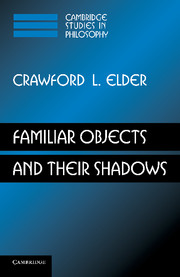Book contents
- Frontmatter
- Contents
- Acknowledgments
- Introduction
- 1 Two false friends of an ontology of familiar objects
- 2 Conventionalism as ontological relativism
- 3 Realism about material objects: persistence, persistence conditions, and natural kinds
- 4 Ontological preference for the temporally small
- 5 Ontological preference for microphysical causes
- 6 Ontological preference for the spatially small
- 7 A third false friend of familiar objects: universal mereological composition
- 8 Concluding Hegelian postscript
- Appendix: “Mutually interfering” dimensions of difference
- References
- Index
Appendix: “Mutually interfering” dimensions of difference
Published online by Cambridge University Press: 25 January 2011
- Frontmatter
- Contents
- Acknowledgments
- Introduction
- 1 Two false friends of an ontology of familiar objects
- 2 Conventionalism as ontological relativism
- 3 Realism about material objects: persistence, persistence conditions, and natural kinds
- 4 Ontological preference for the temporally small
- 5 Ontological preference for microphysical causes
- 6 Ontological preference for the spatially small
- 7 A third false friend of familiar objects: universal mereological composition
- 8 Concluding Hegelian postscript
- Appendix: “Mutually interfering” dimensions of difference
- References
- Index
Summary
Contrariety is not defined, I contend, for either the structural properties that typically characterize massive pluralities of microparticles, or for the structural properties that characterize typical universal mereological composition (UMC) objects. That is, there is no fixed and stable phenomenon of “more and less different from” that relates any two such properties to a third. Suppose that c1, c2, and c3 are structural properties of either sort, and at least appear to be contraries of one another. Then I contend that c3's being farther removed than c2 from c1, along some dimension D1 of difference, does not in and of itself amount to c3's being more different than c2 from c1. On the contrary, depending on how c3 and c2 stand towards c1 on other dimensions of difference, c3's being farther away than c2 is from c1, along D1, may amount to c3's being less different from c1 than c2 is. The same is true of any dimension of difference along which c3's difference from c1 may be compared with c2's difference. No dimension trumps all the rest. There is no final, stable product of c2's and c3's relative differences from c1 along all the dimensions of difference.
My experience shows that this contention is initially hard to believe, or perhaps just hard to understand. Initially, it can seem obvious that c2 and c3 each lie at some determinate distance from c1 along D1; that they are each also separated from c1 by some determinate interval along dimension D2; and so on through all the dimensions with respect to which both c2 and c3 both have locations.
- Type
- Chapter
- Information
- Familiar Objects and their Shadows , pp. 190 - 194Publisher: Cambridge University PressPrint publication year: 2011



